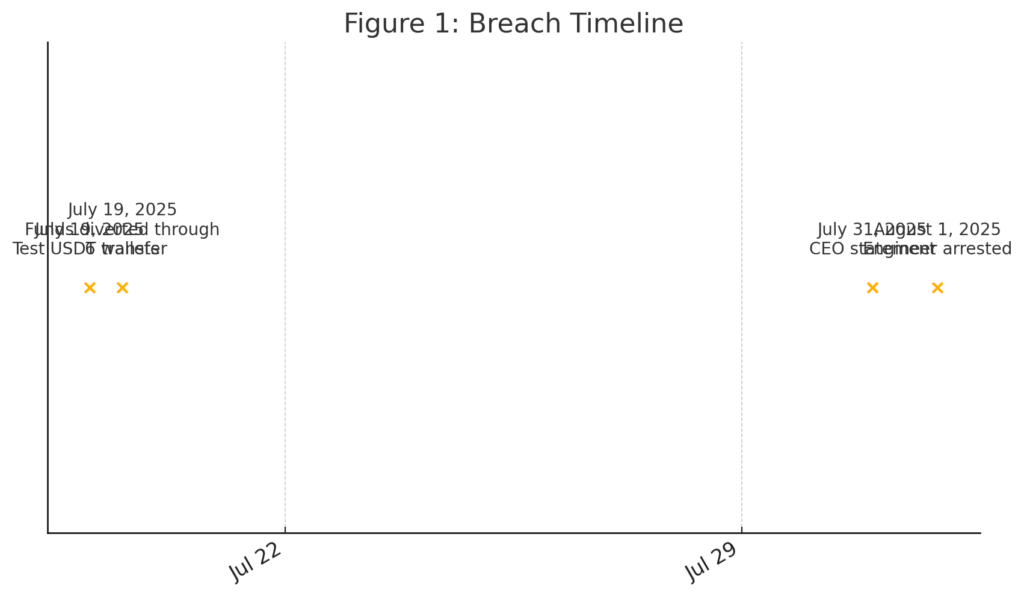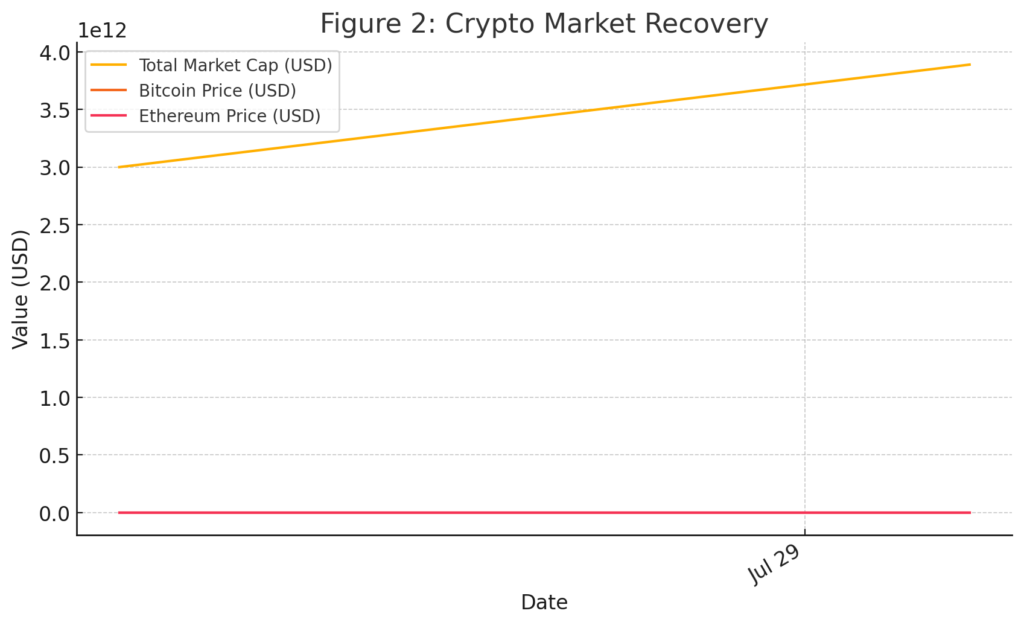
Main Points:
- A CoinDCX software engineer allegedly exploited infected credentials to siphon off $44 million in USDT.
- Key events spanned from a July 19 test transfer to the July 31 CEO statement, with law enforcement arresting the suspect on social-engineering charges.
- CoinDCX launched a “Recovery Bounty Program” offering up to $11 million (25 %) for information leading to fund recovery.
- The broader crypto market quickly rebounded—Bitcoin rose over 30 % in 30 days, Ethereum jumped 57 %, total market cap recovered to $3.89 trillion.
- This breach mirrors the Lazarus Group’s $1.5 billion Bybit attack in February 2025, underscoring persistent insider and social-engineering risks.
- Exchanges must bolster employee training, implement stricter endpoint controls, and proactively hunt for compromised credentials.
1. The Breach Unfolded
On July 19, 2025, unbeknownst to CoinDCX’s security team, a small-scale USDT transfer was executed—marked as a routine test. Within hours, malicious actors had channeled funds through six intermediary wallets, ultimately absconding with approximately $44 million in Tether (USDT). An internal probe later revealed that the attacker leveraged the corporate login of a full-time software engineer, Rahul Agarwal, who held privileged access to production infrastructure.
Investigators believe Agarwal’s company-issued laptop was infected via a single unsolicited file sent from an international contact. The embedded malware captured his credentials, allowing the hacker to ghost into CoinDCX’s internal systems. Although customer wallets remained untouched thanks to segregated cold-storage protocols, the incident exposed grave lapses in endpoint hygiene and social-engineering defense.
Figure 1: Breach Timeline

2. Arrest and Forensic Investigation
On August 1, Karnataka Police executed a warrant to detain Mr. Agarwal in Bengaluru. While he denies intentional complicity, he has admitted to opening a file sent from a German number and holding multiple freelance contracts on the side. Authorities also flagged an unexplained $17,000 deposit into his personal account.
Key forensic findings:
- Malware Log Traces: Artefacts indicated credential exfiltration via a custom Keylogger.
- Transaction Trail: On-chain analysis, popularized by security researcher ZachXBT, mapped the flow across six wallets, each moving roughly $7–8 million USDT.
- Insider Access: Agarwal’s role at Neblio Technologies (a contractor) granted him high-level API keys that bypassed multi-factor challenges.
Police are now tracing the initial phishing vector and seeking any external collaborators. CoinDCX’s CEO, Sumit Gupta, acknowledged cooperation with Karnataka authorities but declined further comment due to the ongoing probe.
3. Corporate Response and Industry Reaction
Facing intense scrutiny, CoinDCX swiftly rolled out a Recovery Bounty Program, pledging up to $11 million (25 % of stolen funds) as reward for credible leads. Meanwhile, the exchange’s Vice President of Public Policy, Hardeep Singh, revealed that an anomalous internal-system alert first flagged the breach—underscoring the value of real-time monitoring.
Social media erupted after blockchain sleuth ZachXBT decried lax employee security:
“Why are insiders still clicking unknown files? This could happen at any exchange.”
Industry peers echoed calls for:
- Rigorous Phishing Simulations: Frequent red-team exercises to sharpen staff vigilance.
- Zero-Trust Endpoint Controls: Application whitelisting and hardware-backed MFA for employee logins.
- Enhanced On-Chain Alerts: Automated watchlists for multi-million-dollar outflows to unfamiliar wallets.
4. Market Impact and Figures
Despite the alarm, the broader crypto market demonstrated resilience. Within one month, major assets not only recovered but posted significant gains:
Figure 2: Crypto Market Recovery

- Total Market Capitalization: Rebounded to $3.89 trillion, erasing early-July losses.
- Bitcoin (BTC): Surged over 30 %, climbing past $118,000.
- Ethereum (ETH): Jumped 57 %, settling around $3,857.
This swift rebound suggests investor confidence in exchange security reforms and robust on-chain fundamentals. Nonetheless, the parallel to February’s Lazarus Group attack on Bybit (≈$1.5 billion) has heightened calls for end-to-end security audits across all major VASPs.
5. Lessons Learned and Path Forward
The CoinDCX incident underscores several imperatives:
- Employee Education Is Non-Negotiable: Regular phishing drills and rewards for vulnerability reporting foster a security-first culture.
- Proactive Threat Hunting: Continuous scanning for anomalous logins and credential misuse can pre-empt large-scale breaches.
- Incident Transparency: Prompt disclosure and community engagement (e.g., recovery bounties) bolster trust and align stakeholder incentives.
- Regulatory Collaboration: Working hand-in-glove with authorities accelerates investigations and deterrence.
Going forward, exchanges should invest in secure hardware MFA tokens, deploy deception technology within critical networks, and integrate on-chain intelligence platforms to spot suspicious fund movements in real time.
Conclusion
The $44 million breach at CoinDCX serves as a stark reminder that insider risks and social-engineering tactics remain the Achilles’ heel of even well-resourced exchanges. While customer assets were safeguarded, and the market recovered swiftly, the incident has catalyzed an industry-wide reckoning. By combining rigorous employee training, zero-trust architectures, and transparent recovery programs, VASPs can turn today’s crisis into tomorrow’s security benchmark. Vigilance, not complacency, must now guide every phase of cryptocurrency exchange operations.

